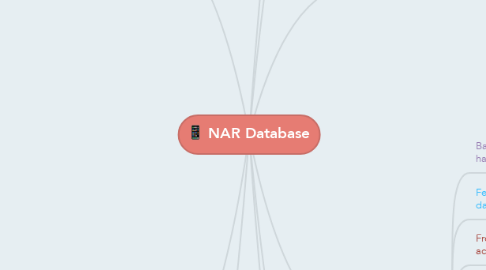NAR Database
by emirul iskandar

1. Major grouping of database
1.1. Nucleic acid sequence & structure
1.2. Protein sequence & structure
1.3. Metabolic & signaling pathways
1.4. Viruses, bacteria, protozoa & fungi
1.5. Genomes of human & model organism
1.6. Human diseases & drugs
1.7. Plants
1.8. Others (Mitochondrial database & database of chemical compounds)
1.9. RNA sequence database
1.10. Structure database
1.11. Genomic database (non-vertebrate)
1.12. Microarray data & other genome expansion database
1.13. Proteomic resources
1.14. Organelle database
1.15. Immunological database
1.16. Cell biology
2. Organization in database
2.1. NCBI
2.2. EMBL - EBI
2.3. SIB
3. No. available
3.1. 88 new resources
3.2. 23 obsolete websites
3.3. 1685 databases
3.4. 15 categories
3.5. 14 subcategories
4. Why database are created, saved & shared?
4.1. Provide a general introduction into their activities that should be useful for both experienced and novice users
4.2. Introductory paper describes the web resources that are supported
4.3. To make info being spread faster
4.4. To store the biological data & organize it properly
4.5. Everyone can access to the database easier
4.6. Maintain record for ongoing use
4.7. All data kept in one place (security)
4.8. Keep updated on new discovery
5. Why database need to be grouped?
5.1. These general categories may only partly reflect the database scope, so we can encourage the reader to browse the entire table of contents: a useful database might be found in a totally unexpected bin
5.2. Easy to get the information because its already classify into categories
5.3. A significant fraction of databases are dedicated to variation of valid results
5.4. Type and numbers of databases continue to increase
5.5. Systematic & standards template as reference in searching database
6. Why some database are no longer in database & dropped from it?
6.1. There is some improvement in database & technologies, so its need to be update to give the recent results
6.2. Non-responsive data (121 databases)
6.3. Taken the commercial route & does not provide free version
6.4. Integrated into larger project
7. Criteria
7.1. Based on previous issue that had been published
7.2. Featuring well curated databases
7.3. Free and easy to access
7.4. Database abundancy
7.5. Web accessible database that offer carefully curated data that not available elsewhere
7.6. Scientific research originality with granted patent
7.7. Not for new experimental result
7.8. Must contain adequate help materials for every use by first-time users
8. Definition database
8.1. Collection of information that is organized so that it can easily be access, managed and updated
9. About NAR
9.1. A collection of various molecular biology database @ open access journal
9.2. 23rd annual database issue of 178 papers
9.3. 62 new online database
9.4. 95 updates on previous database featured in NAR
9.5. 17 updates on database published in other journal


